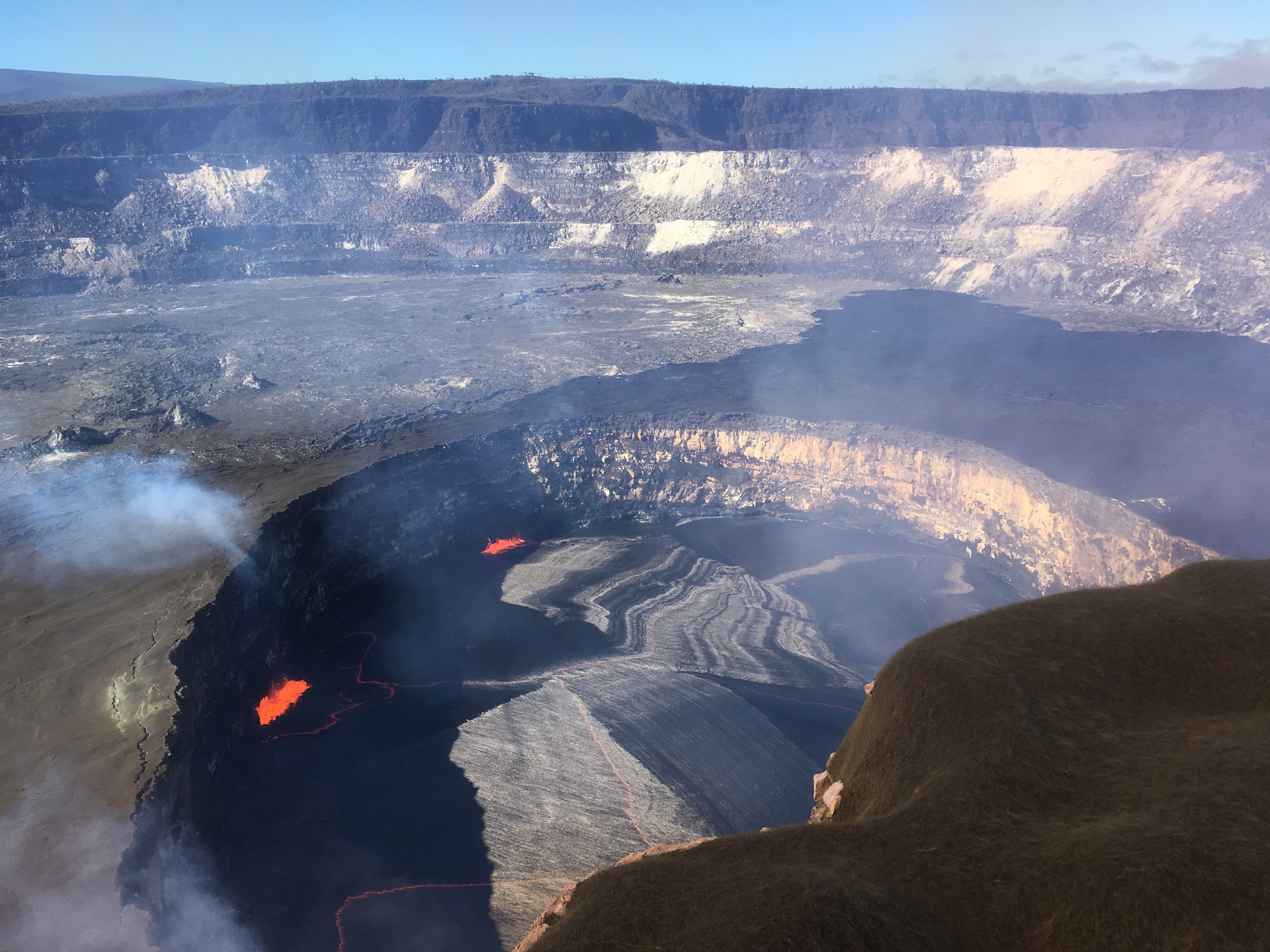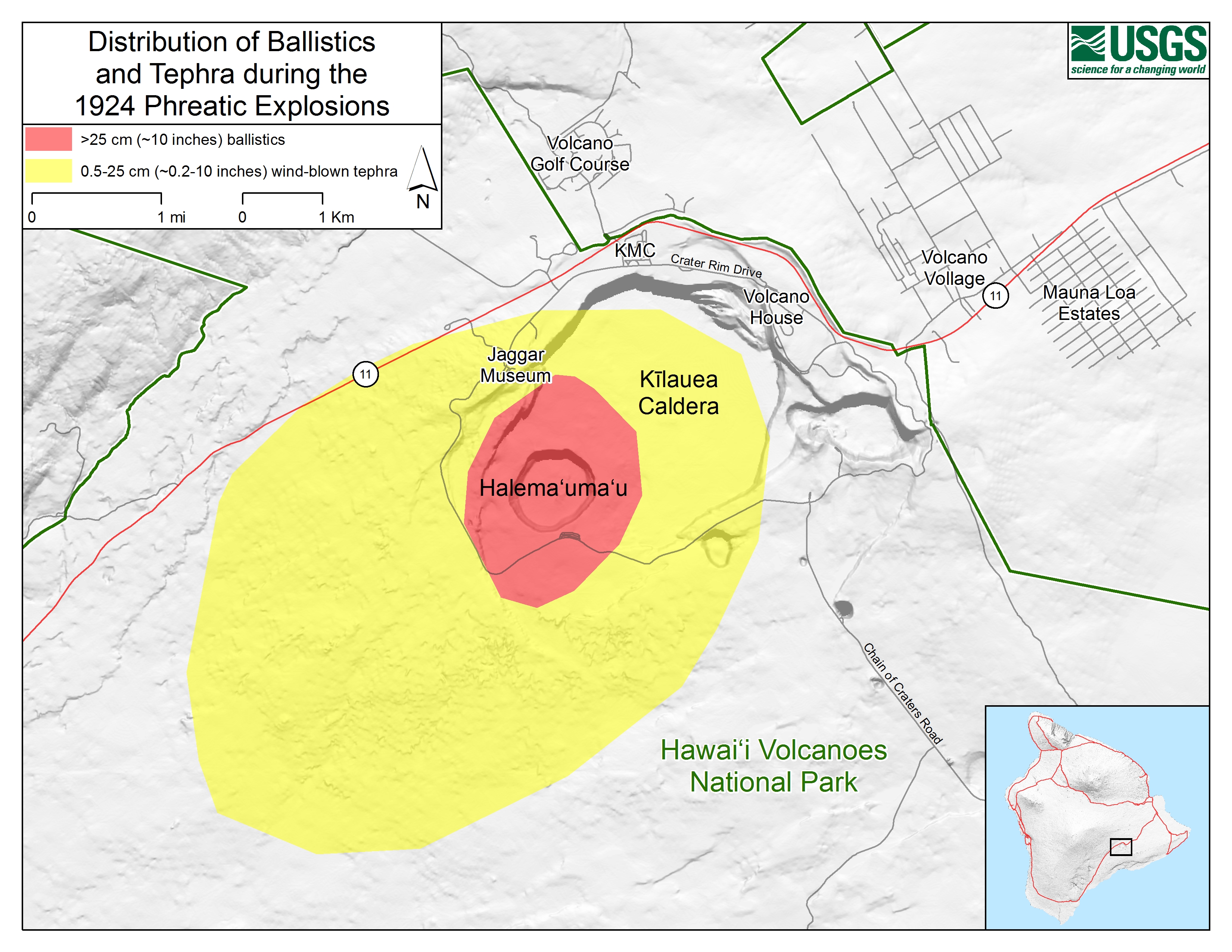Volcano Watch: It’s An Extraordinary Time on Kīlauea!
Last week’s Volcano Watch focused on the East Rift Zone eruption, which continues to impact the lower Puna District on the Island of Hawaiʻi. Changes in the eruption are occurring daily, if not hourly, so by the time you read this article, the situation will likely have changed. Nevertheless, here’s the status of the eruption as of Friday, May 11, 2018:

On May 2, two days after the significant collapse in Pu‘u ‘Ō‘ō on Kīlauea’s East Rift Zone, the lava lake in “Overlook crater” within Halemaʻumaʻu at the summit of Kīlauea began to drop. The steady lowering of the lava lake over the next week increased the potential for phreatic (steam) explosions at Halemaʻumaʻu, which has resulted in the closure of Hawaiʻi Volcanoes National Park and concern among nearby residents. PC: USGS
Fifteen fissures have erupted in the Leilani Estates area thus far. These outbreaks have typically been short-lived, lasting minutes to hours, with pauses between the fissures ranging from minutes to days. The fissure eruptions have covered about 117 acres with lava and emitted high levels of sulfur dioxide. Earthquake activity, ground deformation measured by GPS, and the opening of new ground cracks east and west of Leilani Estates suggest that this eruption is not over and that additional fissures are likely to open.
The breaking news of this past week, however, was about Kīlauea Volcano’s summit eruption.
On May 2, two days after the significant collapse in Pu‘u ‘Ō‘ō on Kīlauea’s East Rift Zone, the lava lake in “Overlook crater” within Halemaʻumaʻu at the summit of Kīlauea began to drop. The steady lowering of the lava lake over the next week increased the potential for phreatic (steam) explosions at Halemaʻumaʻu, which has resulted in the closure of Hawaiʻi Volcanoes National Park and concern among nearby residents.

On the morning of May 9, 2018, a large rockfall in “Overlook crater” within Halemaʻumaʻu at the summit of Kīlauea triggered a gas-driven explosion that sent an ash plume several thousand feet skyward. Phreatic (steam-driven) explosions can create larger ash plumes; the 1924 explosions sent ash plumes up to 20,000 feet high. USGS photo.
Explosive events have happened at the summit lava lake since the vent first opened in 2008. But those events have been gas-driven explosions caused by rocks falling from the crater walls. Rocks hitting the lake surface cause the release of gases dissolved in the lava, which explosively propels gas and ash upward, forming a dusty ash plume that rises above the lava lake.
Since 2008, more than 60 gas-driven explosions have thrown tephra (general term for airborne volcanic rock fragments) and spatter (fragments of molten lava) onto the Halemaʻumaʻu crater rim. Fine ash particles have also been blown a few miles by wind, creating minor annoyances in downwind areas.
But, phreatic, or steam-driven, explosions are much larger in scale and impacts. These explosions can occur when the lava column within a vent drops below the water table, allowing an influx of groundwater into the still-hot conduit.
The mix of hot rock and water results in the formation of steam. If the conduit remains open, the steam can passively rise to the surface, forming an impressive, but relatively benign, steam plume.
However, rocks falling from the conduit wall can form a plug that effectively chokes the conduit. When this happens, steam below the plug can no longer passively escape, so pressure builds until an explosion blasts through the conduit.

To help us understand what could happen at Kīlauea Volcano’s summit, we look to past similar events, but this does not mean that future events will be exactly the same. This map shows the distribution of ballistics and tephra from the 1924 phreatic (steam-driven) explosions. Ballistics (blocks of rock) greater than 10 inches in size, with some weighing up to several tons, landed in the shaded pink area. Marble- to pea-sized rocks (about 0.2–10 inches in size) landed in the yellow shaded area. The surrounding light-colored area was subjected to gritty to fine ashfall, with fallout locations influenced by wind direction at the time of the explosions. The 1924 phreatic explosions are described at: https://volcanoes.usgs.gov/volcanoes/kilauea/geo_hist_1924_halemaumau.html. USGS map.
During a phreatic explosion, large ballistics—boulders weighing up to several tons—can be blasted out in all directions, falling to the ground within about 1 km (0.6 mi) of the conduit. Smaller rocks—marble to pea-sized—can be thrown 5-6 kilometers (up to 4 miles) from Halemaʻumaʻu, but where they land is largely influenced by wind direction.
Phreatic explosions can produce towering plumes of gritty to fine ash that can be blown farther downwind, possibly tens of kilometers (20 or more miles). The fallout of ash will not be life-threatening, but it will be a nuisance for downwind communities. The thickness of ash deposits at a given location can range from a fine dusting to fractions of an inch, but the total thickness can add up with multiple explosions.
It’s important to note that it’s not 100 percent certain that a phreatic explosion will occur at the summit of Kīlauea. But, based on the disappearance of the summit lava lake (it has now drained completely from view) and geophysical models, there’s a possibility that phreatic explosions could happen in the coming days or weeks. We must also note that these explosions can occur with no—or very little—warning.
Residents living near or downwind of Kīlauea’s summit area should learn about ashfall hazards, stay informed of the volcano’s status, heed all closures, and review family and business emergency plans. For more information about Kīlauea summit ash hazards click here.
Volcano Activity Updates:
This past week, Kīlauea Volcano’s summit lava lake level dropped out of view. On Kīlauea’s East Rift Zone, the 61g lava flow is no longer active. Episode 62 fissures on the lower East Rift Zone are expected to continue erupting intermittently.
Mauna Loa is not erupting. Rates of deformation and seismicity have not changed significantly over the past week, and have decreased compared to earlier in the year.
Fifty earthquakes were reported felt in Hawaiʻi during the past week. Many were aftershocks associated with the magnitude-6.9 earthquake on May 4. Additional felt earthquakes should be expected in the coming days to weeks.
Volcano Watch is a weekly article and activity update written by US Geological Survey Hawaiian Volcano Observatory scientists and affiliates.








